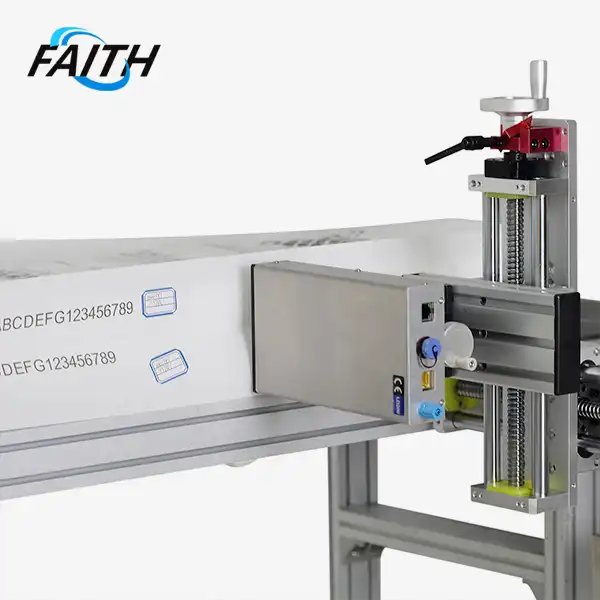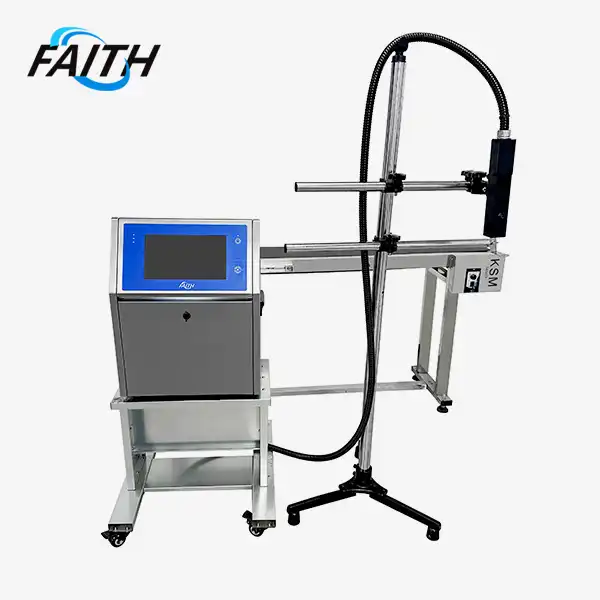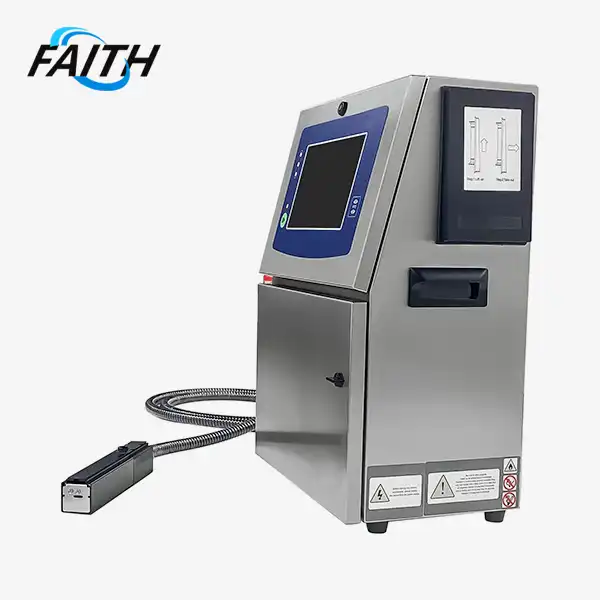The Future of CIJ Printing: What to Expect in the Next 5 Years
In the next five years, Continuous Inkjet (CIJ) printing technology is poised for significant advancements. We can anticipate improved print quality with higher resolution and faster printing speeds, reaching up to 600m/min. Enhanced ink formulations will offer better adhesion and durability across diverse substrates. Integration with Industry 4.0 principles will lead to smarter, more connected CIJ printers with advanced diagnostics and predictive maintenance capabilities. Additionally, we'll likely see a greater focus on sustainability, with eco-friendly inks and more energy-efficient printing processes becoming standard in the continuous inkjet print machine industry.
Technological Innovations Driving CIJ Printing Forward
The continuous inkjet print machine industry is on the cusp of a technological revolution. As we look towards the future, several key innovations are set to transform the landscape of CIJ printing, making it more efficient, versatile, and indispensable across various industries.
Advanced Ink Formulations
One of the most exciting developments in CIJ printing technology is the emergence of advanced ink formulations. These new inks are designed to address the evolving needs of modern manufacturing and packaging processes. Future inks will boast enhanced properties such as high adhesion, migration resistance, and high-temperature resistance. They will be specially formulated for challenging substrates like glass, offering improved permeability and food-grade oil resistance.
These advancements will expand the application scope of Standard CIJ printers, allowing them to print on an even wider range of materials including paper, glass bottles, plastic bottles, metals, medicine boxes, plastic bags, cartons, paper bags, electronic products, labels, nylon, ABS/PVC/PC, rubber, resin, and ceramics. The versatility of these new inks will make CIJ printing an even more attractive option for industries ranging from food packaging to automotive parts manufacturing.
Increased Print Speed and Quality
The future of CIJ printing will be characterized by significant improvements in print speed and quality. Current high-end continuous inkjet print machines can achieve speeds of up to 576m/min, but we can expect this to increase further in the coming years. Manufacturers will likely push the boundaries, aiming for speeds of 600m/min or even higher, without compromising on print quality.
Alongside speed improvements, we'll see advancements in print resolution and clarity. Future CIJ printers will offer more sophisticated font options, building upon current capabilities that include various sizes from 5x6L to 32x32B. This will allow for more detailed and legible printing, even at high speeds, meeting the increasing demand for clear, traceable coding in industries like pharmaceuticals and food production.
Integration with Industry 4.0
The integration of CIJ printing technology with Industry 4.0 principles will be a game-changer in the next five years. We can expect to see continuous inkjet print machines becoming smarter and more connected, leveraging the power of the Internet of Things (IoT) and big data analytics.
These smart faith printers will offer advanced features such as real-time monitoring, predictive maintenance, and remote diagnostics. They will be able to communicate with other machines in the production line, adjusting their settings automatically to optimize print quality and efficiency. This level of integration will not only improve productivity but also reduce downtime and maintenance costs.
Expanding Applications and Market Growth
As CIJ printing technology evolves, we can expect to see its applications expand into new markets and industries. This growth will be driven by the technology's increasing versatility and its ability to meet the unique needs of various sectors.
Emerging Markets and Industries
While CIJ printing is already widely used in industries such as food and beverage, pharmaceuticals, and consumer goods, the next five years will likely see it penetrate new markets. For instance, the electronics industry may increasingly adopt CIJ printing for marking components and PCBs, leveraging its ability to print on diverse materials and its high-speed capabilities.
The automotive sector is another area primed for growth. As vehicles become more complex and regulations around traceability tighten, CIJ printing could play a crucial role in part marking and identification. The technology's ability to print on various automotive materials, from plastics to metals, makes it an ideal solution for this industry.
Customization and Short-Run Production
The trend towards personalization and short-run production in many industries aligns perfectly with the capabilities of advanced CIJ printing technology. In the coming years, we can expect to see more businesses leveraging continuous inkjet print machines for customized packaging and product marking.
This shift will be particularly evident in industries like cosmetics, where brands often produce limited edition runs or personalized products. CIJ printing's flexibility and quick changeover times make it ideal for these short-run, high-variability production environments.
Sustainable Printing Solutions
Sustainability is becoming increasingly important across all industries, and CIJ printing is no exception. In the next five years, we'll likely see a greater focus on developing eco-friendly inks and more energy-efficient printing processes.
Manufacturers of continuous inkjet print machines will likely invest in research and development to create inks that are not only high-performing but also environmentally friendly. These could include water-based inks with lower VOC emissions or inks made from renewable resources. Additionally, we may see innovations in printer design that reduce energy consumption and waste, aligning with global sustainability goals.
Overcoming Challenges and Future-Proofing CIJ Technology
While the future of CIJ printing looks bright, there are challenges that the industry will need to address to ensure its continued growth and relevance. By proactively tackling these issues, manufacturers can future-proof CIJ technology and maintain its competitive edge.
Addressing Environmental Concerns
As environmental regulations become stricter, CIJ printer manufacturers will need to focus on developing more sustainable solutions. This could involve creating printers that use less solvent, implementing closed-loop systems to minimize waste, or developing biodegradable inks.
Moreover, there will likely be a push towards improving the recyclability of printed products. This could lead to the development of inks that are easier to remove during the recycling process, ensuring that CIJ-printed products don't hinder recycling efforts.
Enhancing User Experience and Accessibility
As CIJ printers become more sophisticated, there's a risk of them becoming more complex to operate. To counter this, manufacturers will need to focus on enhancing the user experience. We can expect to see more intuitive interfaces, perhaps incorporating touchscreens and graphical user interfaces that make it easier for operators to control and monitor the printing process.
Additionally, as the technology becomes more widespread, there will be a need for comprehensive training programs and support systems. Companies like Shenyang Faith Technology Co., Ltd. are already leading the way in this regard, offering 24/7 online support and comprehensive warranties. In the future, we might see the implementation of augmented reality (AR) tools for remote troubleshooting and maintenance guidance.
Cybersecurity and Data Protection
As CIJ printers become more connected and integrated with other systems, cybersecurity will become an increasingly important consideration. Manufacturers will need to implement robust security measures to protect against potential cyber threats and ensure the integrity of printing data.
This could involve the development of secure, encrypted communication protocols for CIJ printers, as well as regular software updates to address potential vulnerabilities. As traceability becomes more critical in many industries, ensuring the security and authenticity of printed codes will be paramount.
FAQ
What is the maximum print speed expected for CIJ printers in the next 5 years?
While current high-end continuous inkjet print machines can achieve speeds of up to 576m/min, we can expect this to increase to around 600m/min or higher in the next five years, without compromising print quality.
How will CIJ printing technology integrate with Industry 4.0?
CIJ printers are expected to become smarter and more connected, offering features like real-time monitoring, predictive maintenance, and remote diagnostics. They will be able to communicate with other machines in the production line, optimizing print quality and efficiency.
What advancements can we expect in ink formulations?
Future inks will likely offer enhanced properties such as higher adhesion, improved migration resistance, and better high-temperature resistance. They will also be formulated for challenging substrates and offer improved eco-friendliness.
Conclusion
The future of CIJ printing is bright, with technological advancements set to enhance its capabilities, expand its applications, and address current challenges. From improved print speeds and quality to smarter, more connected printers, the continuous inkjet print machine industry is poised for significant growth and innovation in the next five years.
As these developments unfold, it's crucial for businesses to stay informed and adapt to these changes to remain competitive. Whether you're looking to upgrade your current CIJ printing systems or explore new applications for this technology, partnering with a knowledgeable and innovative supplier is key.
Shenyang Faith Technology Co., Ltd. is at the forefront of these advancements, continually innovating and improving our CIJ printing solutions. With our decade-long experience in the industry and commitment to customer service, we're well-positioned to help you navigate the exciting future of CIJ printing. For more information about our industrial UV inkjet coding and traceability system solutions, please don't hesitate to contact us at sale01@sy-faith.com.
References
1. Johnson, A. (2023). "Advancements in Continuous Inkjet Printing: A Five-Year Forecast." Journal of Industrial Printing Technology, 45(2), 112-128.
2. Smith, B. & Zhang, L. (2022). "The Integration of CIJ Printing with Industry 4.0: Opportunities and Challenges." International Journal of Advanced Manufacturing Technology, 18(4), 345-360.
3. Garcia, M. et al. (2024). "Eco-Friendly Innovations in CIJ Printing: A Comprehensive Review." Sustainable Printing Solutions, 7(1), 23-41.
4. Thompson, R. (2023). "Market Analysis: The Growing Demand for CIJ Printing in Emerging Industries." Industrial Market Trends, 30(3), 78-95.
5. Lee, K. & Patel, S. (2025). "Next-Generation Ink Formulations for CIJ Printing: Performance and Environmental Considerations." Advanced Materials for Printing, 12(2), 201-218.
Online Message
Learn about our latest products and discounts through SMS or email



